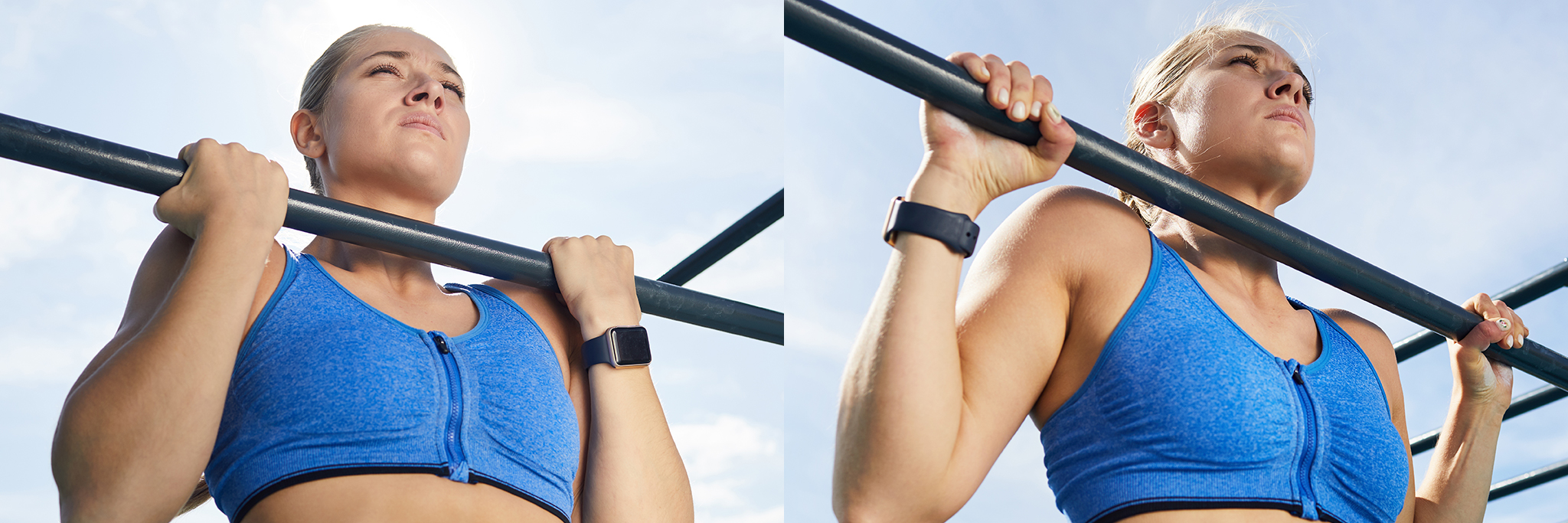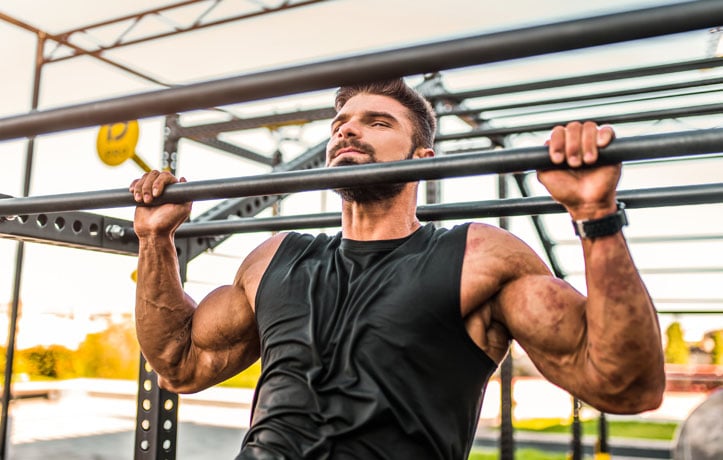If you enjoy the convenience of bodyweight exercises and the challenge that they bring, then you may already know that chin ups and pull-ups are among the most effective bodyweight exercises to strengthen and develop muscles in the upper body.
Don’t let the fact that their bodyweight exercises fool you; these demanding moves require proper form and technique to build strength and prevent injury. In this article, you’ll learn the difference between chin ups and pull ups (yes, there really is a difference!), how to do these moves properly, different variations to try, and the benefits of including them in your next workout.
● The Difference Between Pull Ups and Chin Ups
● Correct Form: Chin Ups & Pull Ups
● Variations of Pull Ups & Chin Ups
● The Benefits of Chin Ups & Pull Ups
● Example Workout
The Difference Between Pull Ups and Chin Ups
While the terms ‘pull up’ and ‘chin up’ are sometimes used interchangeably, they are actually two different exercises. Although they are similar movements, they utilize different grips and hand positions that will slightly change the way they work your back muscles. Knowing the difference between the two can help you choose which move is right for you based on your personal goals.

Chin Ups
A chin up is performed with a supinated grip (your palms facing you) with your hands shoulder-width apart or slightly closer. Biomechanically, chin ups use shoulder extension as the elbows are pulled down and back during the movement, engaging the posterior deltoid and teres major.
The lats are the main muscle group being strengthened, but because of the hand positioning, chin ups recruit significant help from the biceps, taking some work off the lats. Because of this, you might find chin ups easier to do than pull ups.
Pull Ups
A pull up is performed with an overhand grip (palms facing away from you) with your hands slightly wider than shoulder-width apart. Biomechanically, pull ups use shoulder adduction as the elbows pull down and back from the sides during the movement, training the lats and upper back in a slightly different way than chin ups.
Pull ups use the lats, rhomboids, traps, shoulders, posterior deltoids, and brachialis. Because of the overhand grip, your lats will do the majority of the work since they are getting less help from the biceps.
Why are pull ups harder than chin ups?
The wider overhand grip used in pull ups places a greater demand on the lats with less help from the biceps, making this move feel more challenging.
Which exercise is better?
Just because an exercise is “harder” doesn’t necessarily mean that it’s better. Both chin ups and pull ups are great to include in your workouts as you work to build upper body and back strength. You might choose one over the other based on your ability to perform it with good form (that’s how you get the results, after all!), or based on the muscles you’d like to emphasize in your workout.
💪🏻 Get back-to-basics training tips from the "Random Fit" podcast. Join Master Instructors, Wendy Batts, and Ken Miller as they cover the fundamentals of working out every day.
Correct Form: Chin Ups & Pull Ups
An exercise is only as effective as your form is good. Proper form and technique keep you injury free while also making sure that the right muscles are doing their part to produce the movement. Follow these tips to maximize your results while performing chin ups and pull ups:
Chin Up Form
● Hang from the bar with a firm grip, palms facing towards you.
● Keep your shoulder blades engaged and pulled down and back.
● Begin the movement by pulling your elbows down and back to lift your body.
● Try to get your chin over the bar, maintaining a neutral spine.
● Lower yourself down slowly and with control to complete each repetition.
Pull-Up Form
How to do a Pull-Up|Proper Form & Technique|NASM
● Hang from the bar with a firm grip, palms facing away.
● Engage your shoulder blades by pulling them down and back.
● Initiate the movement by pulling your elbows down to lift your body.
● Aim to get your chin over the bar, without arching your back excessively.
● Lower yourself down in a controlled manner to complete one repetition.
💪🏻 Want to master pull-ups? Add a compelling copy here and hyperlink to check out the how to get better at pull-up guide.
Risks and Injury Prevention
The last thing you want to have happen is an injury during a workout. Even though chin ups and pull ups are bodyweight movements, there is still a possibility for injury when done improperly. Here’s how you can prevent some of the most common injuries related to chin ups and pull ups.
Shoulder Strain
The first injury to prevent is shoulder strain. This injury can happen either with overuse or improper form causing strain to the shoulder joint and muscles. Before attempting chin ups or pull-ups, it’s important to establish good stability and strength in and around the shoulder joint to build a solid base. From there, follow proper progressions to work toward your first chin up or pull up. During chin ups and pull ups, focus on proper scapular positioning and controlled movements to prevent unnecessary strain to the shoulder joint.
Elbow Tendonitis
This pesky overuse injury is most often associated with doing a repeated high volume of work without adequate recovery. The best way to avoid elbow tendonitis is to gradually increase your intensity over time and incorporate rest days between chin up or pull up practice days.
Variations of Pull-Ups and Chin Ups
If you’re looking for even more variation in your upper body pull movements, then you have some options. You might choose to include these variations just to mix things up or to reap the unique benefits that each variation offers.
Neutral Grip Pull-Ups
Neutral grip pull ups are performed with the palms facing each other. Like chin ups, this variation allows the biceps to share the load with the lats, but this grip places less stress on the wrists and shoulders. Give this variation a try if your wrists or shoulders need a break.
Wide Grip Pull-Ups
Place your hands even wider than traditional pull ups to perform the wide grip variation. The change in hand placement increases lat engagement (also making this move more difficult than traditional pull ups) and will aesthetically build a broader upper back.
Close Grip Chin Ups
Alternatively, you can try a close grip chin up by placing your hands closer together than a traditional chin up to emphasize bicep activation. This can be a great place to start when practicing chin ups since the biceps will take on even more of the load. Be forewarned that this variation does also challenge grip strength – an important component in being able to do chin ups and pull ups alike!
Assisted Pull-Ups and Chin Ups
Using a resistance band or an assisted machine is a great place to start as you’re beginning your pull up/chin up journey. You can find the amount of assistance that you need to complete the move with good form and slowly decrease assistance over time until you’re ready to perform your first unassisted chin up/pull up.
How Many Reps and Sets?
Beginners: Start with 2-3 sets of 5-8 reps.
Intermediate/Advanced: Aim for 3-4 sets of 8-12 reps.
There are two ways to increase intensity: increasing weight, or increasing volume. Is your goal to complete a certain number of chin ups/pull ups? Or are you aiming to build maximal strength (which typically occurs in the 1-5 rep range with 85-100% intensity)? Once you know your goal, progressing is easy.
To increase volume, you will slowly increase the total number of reps that you do in a workout to help you build toward your ultimate goal (example goal: perform 15 pull-ups). If your goal is maximum strength, you can try adding weight to a belt during your sets once you’ve mastered bodyweight at the rep ranges listed above. Start by adding 5 pounds at a time and slowly increase over time as your form allows.
Benefits of Pull-Ups and Chin Ups
Need more convincing? There are more benefits to being able to perform pull-ups and chin ups than just looking really cool at the gym (because let’s be honest, they do look pretty awesome). Check out these other enticing reasons why you should incorporate pull ups and chin ups into your weekly routine:
Strengthens Upper Body Muscles
Pull ups and chin ups are a multi-joint movement, meaning that they engage multiple muscle groups (lats, biceps, shoulders, and upper back). They promote overall upper body muscle development and can lead to some serious strength gains.
Improves Grip Strength
Grip strength is critical in being able to lift heavier in a variety of exercises that require you to hold the weight, but it is also important as we age. Chin ups and pull ups challenge forearm and hand strength to help you build and maintain better grip strength.
Functional Movement
Should you ever find yourself hanging from a cliff, pull-ups would come in handy. But in all seriousness, pulling is one of the basic human movement patterns that we all need to master for healthy functional fitness. Pull-ups and chin ups are challenging pull movement that also enhance overall physical performance by improving upper body strength.
Convenience and Accessibility
Pull ups and chin ups can be performed almost anywhere: at the gym, at home using a pull up bar, or virtually anywhere that you can (safely) hang a suspension system. Because these movements require minimal equipment, they are ideal for any fitness enthusiast from gym goer to world traveler.
Example Pull Up & Chin Up Workout Routine
● Warm-up
○ 5-10 minutes of light cardio or dynamic stretching.
● Neutral Grip Pull Ups
○ 3 sets of 8 reps.
● Wide Grip Pull Ups
○ 3 sets of 8 reps.
● Close Grip Chin Ups
○ 3 sets of 10 reps.
● Assisted Pull Ups
○ 2 sets of 8 reps (using resistance bands).
● Chin Ups
○ 3 sets of 8 reps.
● Cooldown
○ 5 minutes of static stretching.
Final Thoughts
Pull ups and chin ups are extremely effective when it comes to building upper body and back strength. Gradual progression over time will allow you to perform chin ups and pull ups with good form to reduce the risk of injury and to see the results that you’re looking for. Incorporate these exercises into your fitness routine for a fun yet challenging upper body exercise that’s sure to yield great results.

















